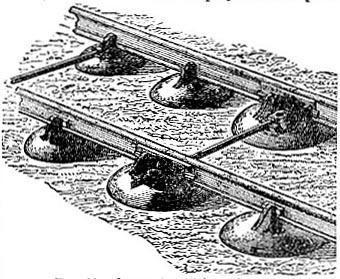1902 Encyclopedia > Railway, Railways (Railroad) > Metallic Permanent Way
Railway, Railways
(Part 28)
E. PERMANENT WAY (cont.)
Metallic Permanent Way
Metallic permanent way, in which the sleepers are of iron, has been much employed in tropical countries, and is now to some extent adopted in France and in Germany.

Fig. 38. Greaves's cast-iron sleepers.
The oldest and most widely used system of metallic way is that of Mr. H. Greaves, who in 1846 introduced a spherical or bowl sleeper of cast-iron, having the chair for the rail cast on its summit (see fig. 38). Every second pair of sleepers are connected and held to gauge by transverse tie-bars, which pass through and are bolted to them. The form of the sleeper is strong, it holds well in the ground, the chair is not liable to be detached, the whole bearing surface is directly beneath the road, the ballast is kept dry and elastic, and there is a simple means of packing the sleeper through holes in the top, with a pointed rammer from the surface, so that the sleeper and the rail can be forced upwards without disturbing the general bed of ballast. They may also be lowered by taking out a portion of ballast from the interior.

Fig. 39. Suspended girder rail.
Another system, Mr. W. Bridges Adams’s "suspended girder rail," is shown in fig. 39. The rail is 7 inches deep, weighing 65 lb per lineal yard, and is suspended by continuous angle-wires, or side wings bolted to it, and bedded in the ballast; and, as the bearing surface on the ballast was approximated to the bearing surface of the rail, a great degree of stability was anticipated. Wrought-iron transverse sleepers were first tried in Belgium in 1862, then in France and in Portugal, and afterwards in Germany. There are various systems, most of which were unsatisfactory, but the Vautherin Sleeper, first tried in 1864 on the Lyons railways, has been successful. It is hollow in section, of the form A truncated, supposing the upper part of the letter to be removed, presenting a flat bearing surface, 3 1/4 inches wide, for a flange rail. It is 8 feet in length and 9 inches wide over the flanges forming the base. It is three-eighths of an inch thick at the centre and is ony half that thickness in the wings. The rail is fixed to the sleeper with gibs and cotters. It has been reported that the motion over the Vautherin Sleepers is much easier than that over sleepers of oak, and that in consequence the cost of maintenance is comparatively low. It is stated that amongst a number of rails laid for trial under similar conditions, some of them on wooden sleepers and some of them on Vautherin sleepers, the number of defective rails amounted to only 2 1/2 per cent. of those laid on Vautherin sleepers against 13 per cent. of those laid on wood. It was found that if the Vautherin sleepers were not at least 8 feet in length they failed at the ends, and that even for this length it was expedient to strengthen them at the angles. It was also found that large and hard ballast, or broken stones or broken slag, aggravated the tendency to give way. Ballast of ashes produced a similar bad effect, and also caused the sleepers to rust. On the contrary, ballast of gravel, of a marly character adapted itself admirably to the form of the sleeper. The system of fastening the rails to the sleepers by gibs and cotters has been abandoned in favour of clips and hook-bolts. The Hartwich system of iron way need not be described here, having always given bad results. The Hilf system of iron way consists of two parts,—an iron longitudinal sleeper and a flange rail of steel. It is simple, easily laid and maintained, and economical. The sleeper is in section like the letter E, bevelled at the angles, having an upper flat surface and three flanges downwards. It is 12 inches wide and about 2 1/2 deep; and it can be rolled to lengths of 30 feet and only one-third of an inch in thickness, and to a weight of 59 lb per yard. The rail is 4·32 inches high, with 2·32 inches width of table, 3·40 width of flange base, and four-tenths of an inch thickness of web. It is rolled in lengths of 30 feet and weighs 51 1/2 lb per yard. It is fish-jointed and is fixed to the sleeper with two rows of bolts and nuts at intervals of from 30 to 40 inches. The gauge is preserved by means of 1-inch tie-rods, screwed at both ends with nuts. One tie-rod is sufficient for each length of rail. The combined rail and sleeper, placed on supports 54 inches apart, can carry 18 tons at their middle, without impairing their elastic strength.
Read the rest of this article:
Railway, Railways - Table of Contents
|
